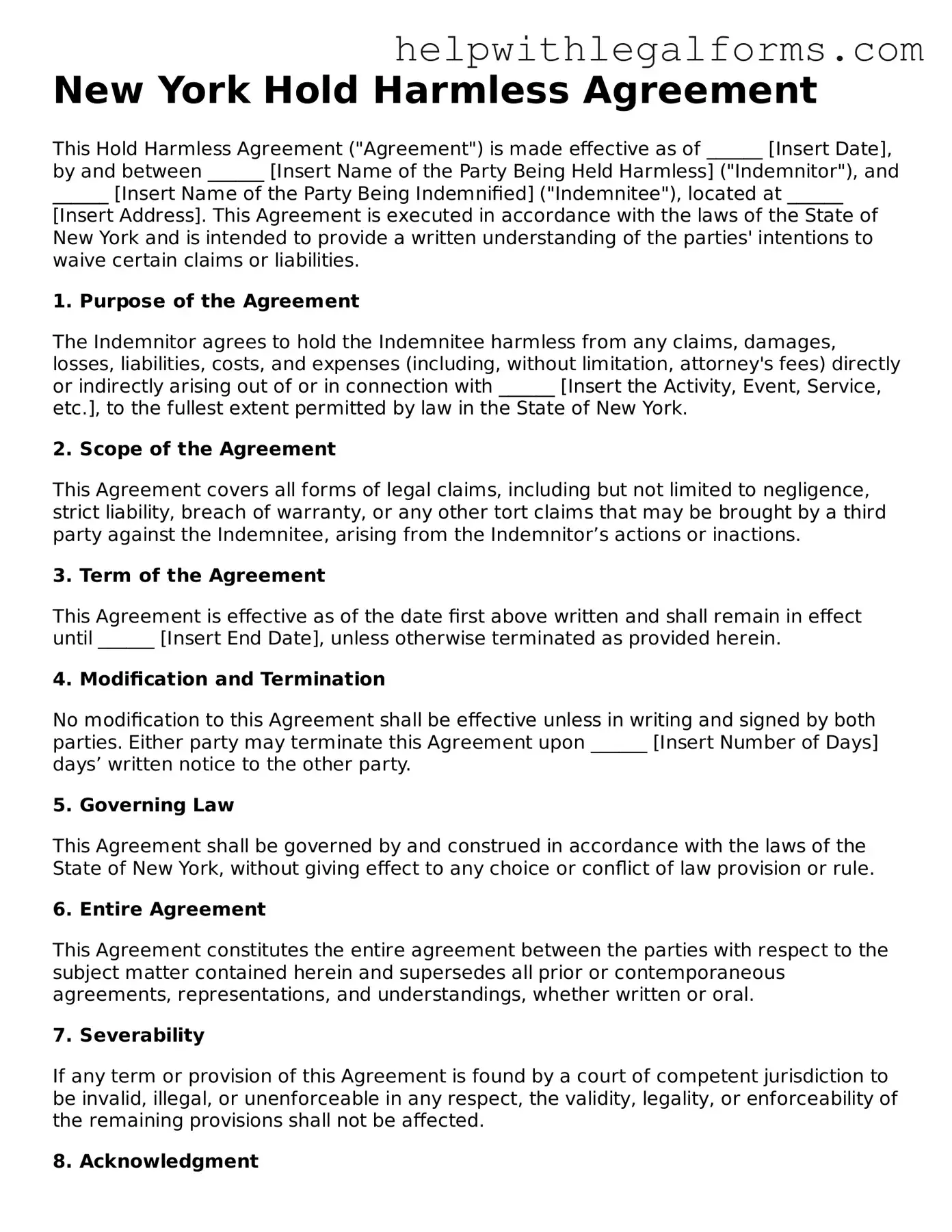New York Hold Harmless Agreement
This Hold Harmless Agreement ("Agreement") is made effective as of ______ [Insert Date], by and between ______ [Insert Name of the Party Being Held Harmless] ("Indemnitor"), and ______ [Insert Name of the Party Being Indemnified] ("Indemnitee"), located at ______ [Insert Address]. This Agreement is executed in accordance with the laws of the State of New York and is intended to provide a written understanding of the parties' intentions to waive certain claims or liabilities.
1. Purpose of the Agreement
The Indemnitor agrees to hold the Indemnitee harmless from any claims, damages, losses, liabilities, costs, and expenses (including, without limitation, attorney's fees) directly or indirectly arising out of or in connection with ______ [Insert the Activity, Event, Service, etc.], to the fullest extent permitted by law in the State of New York.
2. Scope of the Agreement
This Agreement covers all forms of legal claims, including but not limited to negligence, strict liability, breach of warranty, or any other tort claims that may be brought by a third party against the Indemnitee, arising from the Indemnitor’s actions or inactions.
3. Term of the Agreement
This Agreement is effective as of the date first above written and shall remain in effect until ______ [Insert End Date], unless otherwise terminated as provided herein.
4. Modification and Termination
No modification to this Agreement shall be effective unless in writing and signed by both parties. Either party may terminate this Agreement upon ______ [Insert Number of Days] days’ written notice to the other party.
5. Governing Law
This Agreement shall be governed by and construed in accordance with the laws of the State of New York, without giving effect to any choice or conflict of law provision or rule.
6. Entire Agreement
This Agreement constitutes the entire agreement between the parties with respect to the subject matter contained herein and supersedes all prior or contemporaneous agreements, representations, and understandings, whether written or oral.
7. Severability
If any term or provision of this Agreement is found by a court of competent jurisdiction to be invalid, illegal, or unenforceable in any respect, the validity, legality, or enforceability of the remaining provisions shall not be affected.
8. Acknowledgment
IN WITNESS WHEREOF, the parties hereto have executed this Agreement as of the date first above written.
_____________________________
Signature of Indemnitor
_____________________________
Signature of Indemnitee
Printed Names and Titles:
Indemnitor: ______ [Printed Name], ______ [Title]
Indemnitee: ______ [Printed Name], ______ [Title]
Notary Public:
State of New York
County of ______
On ______ [Insert Date] before me, ______ [Insert Notary’s Name], personally appeared ______ [Name(s) of Signer(s)], who proved to me on the basis of satisfactory evidence to be the person(s) whose name(s) is/are subscribed to the within instrument, and acknowledged to me that he/she/they executed the same in his/her/their authorized capacity(ies), and that by his/her/their signature(s) on the instrument, the person(s), or the entity upon behalf of which the person(s) acted, executed the instrument.
